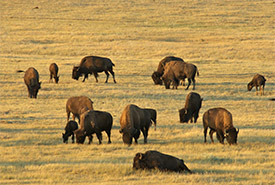Bison management at Old Man on His Back Prairie and Heritage Conservation Area

Plains bison, Old Man on His Back Prairie and Heritage Conservation Area, SK (Photo by NCC)
Established by the Nature Conservancy of Canada (NCC) in 1996, the Old Man on His Back Prairie and Heritage Conservation Area (OMB) is a 5,297-hectare (13,088-acre) ranch located in Treaty Four Territory in southwest Saskatchewan. This area continues to hold cultural and spiritual importance for many Indigenous Peoples, including Anishinaabe, Dakota, Lakota, Nakoda, Nêhiyawak and Niitsitapi.
In 2003, NCC introduced a herd of 50 plains bison (also called buffalo) to reside within the native grasslands at OMB, as part of its management goals of returning large-scale ecosystem processes to the landscape at OMB.
NCC’s Bison Management Plan will guide the next 10 years (2020 to 2030) of our direction with the OMB bison herd. This plan includes Indigenous perspectives on herd management and identifies opportunities where NCC can support ongoing Indigenous connections with the bison herd. This work is undertaken through an Indigenous Advisory Group. The group consists of people from different linguistic and cultural groups with a diversity of knowledge, expertise and experience, all of whom have some interest in potential collaborations around OMB and the bison herd.
Ecological and cultural roles of bison
Bison are large, migratory grazers, and their grazing patterns and preferences shape the vegetation composition, ecosystem function and structure of the Prairies.
Indigenous Peoples have lived alongside bison for thousands of years and historically had hundreds of uses for bison meat, organs, hides and bones. Many of these uses continue today.
Bison is a sacred animal, and in many Indigenous cultures, bison, humans and the land are inextricably linked. Bison are also featured prominently in traditional Indigenous spiritualities, languages and stories, and play an important role in many ceremonies.
Indigenous communities identified a need to access bison, and NCC’s management of the bison herd at OMB could help meet this through:
- Annually hosting a gathering of the Indigenous Advisory Group at OMB, including ceremonies.
- Sharing the Bison Management Plan and NCC’s technical experience with any Indigenous communities interested in learning about NCC’s management of the bison herd.
- Hosting educational events at OMB that provide youth with opportunities to learn about the ecological and cultural roles of plains bison in the grassland ecosystem.
- Regularly providing opportunities for Indigenous communities to harvest bison, or receive meat, skulls and hides.
- Providing live bison to supplement Indigenous bison herds when possible.
NCC is committed to understanding and respecting Indigenous Peoples’ connection to this landscape and to bison. It is important to us that we work together to care for and maintain the herd for both the long-term conservation of this area and the cultural connections with this important species.




